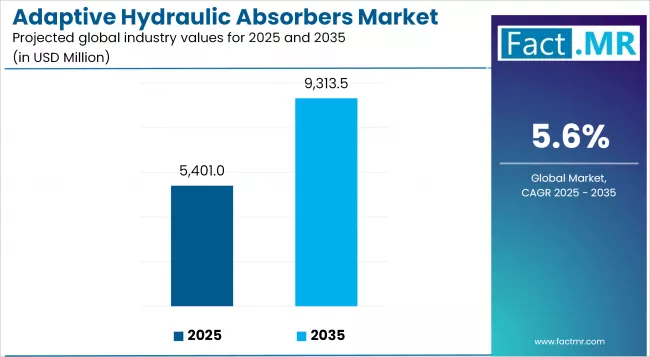The automotive and transportation industries are undergoing a technological transformation, with vehicle safety, comfort, and performance taking center stage. Adaptive hydraulic absorbers are emerging as a crucial component in modern suspension systems, providing real-time damping adjustments to improve ride quality, handling, and stability.
By integrating sensors, hydraulic technology, and electronic control systems, adaptive absorbers enhance driver and passenger comfort while optimizing vehicle dynamics. As consumer expectations for smoother rides and safer vehicles rise, the market for adaptive hydraulic absorbers is witnessing increasing adoption across passenger vehicles, commercial vehicles, and high-performance automotive segments.
Market Overview:
Adaptive hydraulic absorbers are advanced suspension components that automatically adjust damping forces in response to road conditions, vehicle speed, load, and driving behavior. Unlike conventional shock absorbers, adaptive systems use hydraulic mechanisms combined with electronic control units (ECUs) to provide continuous adjustments, ensuring optimal ride comfort and vehicle stability.
These absorbers play a critical role in improving handling, reducing vibrations, and enhancing braking performance. Additionally, they contribute to overall vehicle safety by maintaining consistent tire contact with the road surface, particularly on uneven terrain or during high-speed maneuvers.
The growing focus on premium vehicles, coupled with advancements in intelligent suspension systems, is driving demand for adaptive hydraulic absorbers. Manufacturers are integrating these systems into luxury, sport, and off-road vehicles, as well as in commercial and heavy-duty applications where road conditions can vary significantly.
Regional Insights:
North America
North America leads in the adoption of advanced vehicle suspension systems due to high consumer demand for comfort and safety, as well as the presence of leading automotive manufacturers and suppliers. Investment in intelligent vehicle technologies and the integration of adaptive components in both passenger and commercial vehicles supports market growth.
Europe
Europe is a significant market for adaptive hydraulic absorbers, driven by stringent vehicle safety regulations, high-end automotive production, and widespread consumer awareness. European automakers are investing heavily in adaptive suspension technologies to improve driving dynamics, fuel efficiency, and vehicle safety.
Asia-Pacific
Asia-Pacific is emerging as a major growth region due to increasing vehicle production, rising disposable income, and rapid adoption of premium and high-performance vehicles. Automotive manufacturers in the region are integrating adaptive hydraulic absorbers into new models to meet evolving consumer preferences and regulatory requirements.
Key Trends & Forecast:
- Integration with Intelligent Vehicle Systems
Modern vehicles are increasingly incorporating adaptive hydraulic absorbers as part of integrated chassis and stability management systems. These systems optimize damping response based on real-time sensor inputs, enhancing ride comfort and road handling. - Growth in Luxury and Performance Vehicle Segments
Luxury sedans, SUVs, and high-performance sports cars are major adopters of adaptive suspension systems. Consumers in these segments prioritize driving comfort and stability, driving demand for advanced hydraulic absorbers. - Adoption in Commercial and Off-Road Vehicles
Adaptive hydraulic absorbers are being integrated into commercial trucks, buses, and off-road vehicles to improve load management, ride comfort, and safety under variable driving conditions. - Technological Advancements in Damping Systems
Advances in hydraulic materials, sensor technologies, and electronic control units are enhancing the responsiveness, efficiency, and durability of adaptive absorbers. Smart damping systems now enable precise adjustment in milliseconds, offering superior vehicle dynamics. - Emphasis on Fuel Efficiency and Sustainability
Adaptive hydraulic absorbers contribute to better energy efficiency by reducing unnecessary energy loss from excessive suspension movement. Lightweight designs and optimized hydraulic systems support fuel economy while maintaining high-performance standards.
Applications & End-Use Outlook:
Passenger Vehicles
Adaptive hydraulic absorbers improve ride comfort, handling, and braking performance in passenger cars, particularly for premium and high-performance models. Adjustable suspension enhances driving experience across urban roads, highways, and uneven terrain.
Commercial Vehicles
In commercial trucks and buses, adaptive absorbers help manage heavy loads, reduce vehicle vibration, and improve driver comfort, leading to safer and more efficient operations.
Off-Road and Specialty Vehicles
Vehicles operating in challenging conditions, such as off-road trucks, SUVs, and military applications, benefit from adaptive absorbers that maintain stability and control over rough terrain.
Motorsports and Performance Applications
Racing and performance vehicles increasingly rely on adaptive hydraulic absorbers for precision handling, superior traction, and dynamic response adjustments during high-speed maneuvers.
Technological Landscape:
Hydraulic Control Systems
Advanced hydraulic valves and fluid control mechanisms enable adaptive absorbers to respond quickly to changing road and load conditions, delivering optimal damping performance.
Electronic Control Units (ECUs)
ECUs interpret data from sensors monitoring speed, load, steering, and road surface conditions, adjusting absorber performance in real-time for enhanced vehicle dynamics.
Sensor Integration
Accelerometers, gyroscopes, and displacement sensors provide critical input data to adaptive systems, ensuring precise and responsive damping adjustments.
Lightweight Materials and Design
Use of high-strength alloys, composites, and optimized hydraulic components reduces system weight, contributing to improved vehicle fuel efficiency and overall performance.
Predictive and Adaptive Algorithms
Machine learning and predictive algorithms are being integrated into adaptive systems to anticipate road conditions and driving behavior, providing a smoother and more controlled ride experience.
Industry Outlook & Future Opportunities:
The future of the adaptive hydraulic absorbers market is closely tied to intelligent vehicle systems, autonomous vehicles, and increasing consumer demand for safety and comfort. Key opportunities include:
- Integration with fully autonomous vehicle suspension systems
- Expansion in electric vehicles where weight and efficiency are critical
- Adoption in emerging mobility platforms, such as electric buses and shared transport vehicles
- Continued research into lightweight and eco-friendly hydraulic materials
- Enhanced predictive algorithms for ultra-responsive adaptive damping
As automotive technology evolves, adaptive hydraulic absorbers will play a pivotal role in redefining ride comfort, vehicle safety, and performance standards across multiple vehicle segments.
Conclusion:
The adaptive hydraulic absorbers market is transforming vehicle suspension systems by providing real-time, intelligent damping solutions. By combining hydraulic mechanisms with electronic controls and sensor technologies, these systems enhance passenger comfort, driving stability, and safety across diverse vehicle types. With continued innovation, integration into autonomous and electric vehicles, and rising consumer demand for superior ride experiences, adaptive hydraulic absorbers are set to become a standard feature in modern vehicles, driving the next generation of automotive performance and comfort.
Browse Full Report – https://www.factmr.com/report/adaptive-hydraulic-absorbers-market



